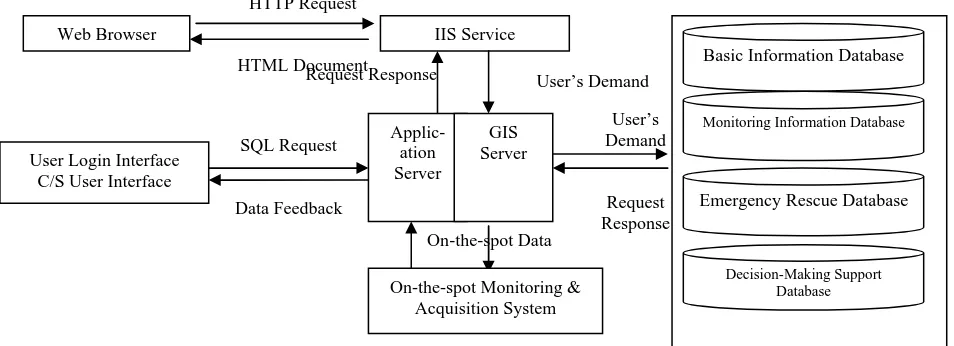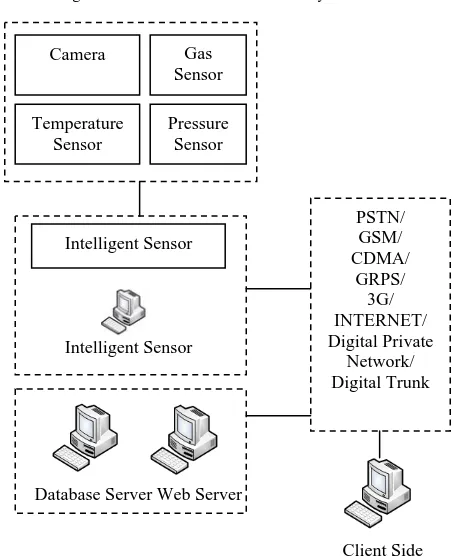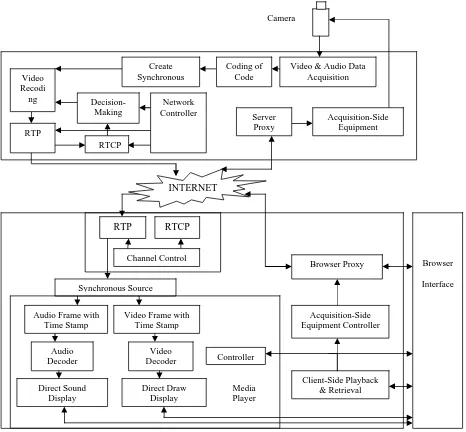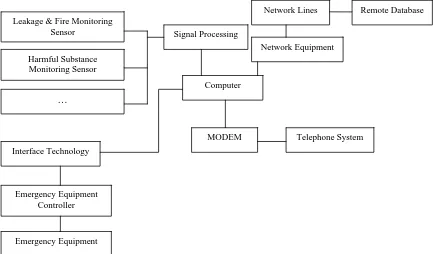Development of Dangerous Source’s Monitoring,
Management and Emergency Rescue
Decision-Making Support Information System
Lele QinHebei University of Science & Technology/ Office of Teaching Affairs, Shijiazhuang, China Email: Mr_qin@163.com
Jinfeng Zhang
Hebei University of Science & Technology/College Environmental Science and Engineering, Shijiazhuang, China Email: Sprjf@126.com
Abstract—Safety production is an everlasting topic of enterprises, and a sound and safe production environment is the basis for enterprises to survive, develop and expand; therefore, monitoring of dangerous source and decision-making of emergency rescue becomes the top priority in creating a sound and safe production environment. On the basis of a comprehensive analysis of the C/S and B/S structure, this thesis proposes the concept of dangerous source’s monitoring & management and emergency rescue decision-making support system which is based on the computer, network, database and GIS technologies. It also further analyzes and researches the system structure, network topology, safety strategy and other matters which construct this system. This system can predict and prevent the accidents and provide important reference for rescue decision-making when accidents happen.
Index Terms—Information System, Dangerous Source, Emergency Rescue, Monitor
I. DANGEROUS SOURCE
At present, China is in the transitional period of economic and social development, the productivity has been developed unprecedentedly and the economy has also been improved greatly. However, it cannot be denied that our safety production awareness is weak, and the contradiction between the relative backward safety monitoring means and rapid development of economy becomes increasingly obvious. Therefore, how to improve the safety management level and accurately and rapidly predict and judge various potential safety hazard and accidents by using the modern methods has become an urgent problem to be coped with at present. Started at the end of last century, China’s research on dangerous source’ s identification, risk assessment and monitoring of enterprise safety production and others has provided technical foundation for survey, risk assessment, monitoring and risk management of major dangerous sources. In recent years, with expansion of enterprises’
scale and increasing complexity of production process, the old single supervision mode is far from meeting the requirement of safety management. In the mean time, with maturity of information technologies, popularization of various development tools (such as VB, DELPHI and C#) and in particular, constant and rapid development of information development technologies based on network, the multi-tier safety production information management system adopting the combination of traditional C/S (Client/ Server) mode and B/S (Browser/Server) mode appears. Our research group has developed the dangerous source's monitoring & management and emergency rescue decision-making support information system based on .NET framework which will well solve the contradiction between enterprise production and safety supervision. Adopting the mixed computing mode based on C/S and B/S, this system features high safety coefficient, good flexibility, high efficiency, etc. and also possesses favorable promotional value.
Dangerous source refers to part, area, place, space, post or equipment and its location in a system, where there are energy and substances that may be released and have potential danger, or which are possible to cause the injury, bring property loss or environmental damage and can become accidents under the action of the trigger. Substantially, it is the source point or part with potential danger, which is the source of accidents, the core where energy and dangerous substances concentrate and the place where energy releases from and bursts out. Dangerous source exists in some established systems, while areas of the dangerous source vary with system scopes. For instance, in the countrywide scope, a specific enterprise (such as an oil refinery) of some dangerous industries (such as petroleum and chemical industries) is a dangerous source. Since dangerous source is the most important factor triggering accidents, whether we can control and monitor the dangerous sources effectively is a major factor to reduce accidents and improve safety management level [1].
Major dangerous source should be controlled hierarchically according to its assessment results. For substances in a unit, the more dangerous they are and the larger the quantity is, the higher the major dangerous Manuscript received December 10, 2010; revised January 20, 2011;
accepted January 26, 2011.
Corresponding author:Lele QIN (Mr_qin@163.com).
source grade is and the more control they demand. Generally, major dangerous source falls into four grades: grade I, II, III and IV, and the corresponding control for the four-grade dangerous sources is divided into A, B and C grade respectively.
The major dangerous source is ultimately controlled by equipment and managed by people; therefore, the production and operation unit should formulate a set of strict safety management system, specifying responsibilities of each category of staffs. As to the monitoring of dangerous sources and accident prevention, there are two points demanding special attention.
The first point is about the operating staff of major dangerous source. We should improve their quality and strengthen the staff training. It demands the staff not only to be familiar with the technological process of facilities and know well about the hazards and the preventive measures, but also to learn the operating experience of the similar facilities, their handling methods in emergencies as well as handling procedures in case of accidents.
The second point is about the monitoring of the major dangerous sources. Adopting high technologies such as data acquisition and computer communication, and in combination with automatic detection and sensing technologies, we establish a monitoring and early-warning system for grade and major dangerous sources to conduct real-time monitoring for the safety conditions of the object danger source, and to monitor the change trend of different parameters at the time when the
dangerous sources transfer to the accident critical condition. The early-warning information or emergency control instruction can nip the accidents in the bud.
In these two points, monitoring dangerous source and predicting accidents becomes the top priority.
II. OVERALL DESIGN OF THE SYSTEM
A. Architecture of the System
This system applies the life cycle approach and its design process includes the stages of system planning, system analysis and system design. With demand as the guidance, this system highlights the quick response, advancement, expandability as well as safety of data transmission. In terms of system mode and function, on the basis of C/S computing mode, this system has the characteristics such as high safety coefficient and high transmission speed. The parts with strong interactivity, high requirement for safety coefficients and relatively large quantity of data transmission (such as online monitoring of dangerous sources and major dangerous sources, acquisition and analysis of data, database management and emergency rescue decision-making computing) adopt the C/S mode; the functions with less interactivity and relatively small quantity of data transmission, such as status viewing, historical data enquiry and simple data input, adopt the B/S mode. The system architecture based on multi-tier C/S+B/S computing mode is shown as Figure 1[2]-[4].
Figure 1 Computing Mode Based on Multi-Tier Mixed C/S and B/S
B. Network Structure Design of the System
In the system, network construction is an important component part which can provide data transmission, operation platform and environmental support for various monitoring and management system, emergency rescue command system and expert system. Through system analysis, in the network structure design, our research group endeavors to increase the transmission pressure of network database to satisfy the customers’ requirements,
and comply with the development tendency of network to cope with the further expansion of the system in the future. The network topology is shown as Figure 2 and the system network is divided into many tiers such as C/S and B/S. The network transmission inside an enterprise is based on Intranet, the system administrators and decision-makers of each department adopt C/S in order to guarantee the smooth transmission and safety of the mass data. In general, administrators view the status through B/S mode for the reason that B/S has the characteristic
SQL Request
Data Feedback
Request Response
Web Browser IIS Service
User Login Interface C/S User Interface
Applic-ation Server
GIS Server
On-the-spot Monitoring & Acquisition System
基础信息数据库
Basic Information Database
Monitoring Information Database
Emergency Rescue Database
Decision-Making Support Database HTTP Request
HTML Document
User’s Demand
Request Response On-the-spot Data
that the current state can be viewed through the IE viewer anywhere and anytime and possesses the functions such as visiting database. Multi-tier network layout can not only realize the information management of enterprise’s data, but also achieve the data exchange and exchange visit of different tiers through data interface. Therefore, it is of great flexibility and can realize different functions according to the requirement of customers.
This system network is not designed as an independent physical network but designed to depend on administrative affairs network. Through constructing
VPN (Virtual Private Network) and taking the enterprise as a data port or client side of VPN, it realizes network connection among all member units of safety work administration and command centers at all levels. In this way, the network connection and data transmission between the emergency rescue command private network and the superior emergency rescue command centers of safety production can be achieved. In the process of design, it is necessary to install the fire wall between each public network area so as to guarantee the connection as well as the safety and independence of internal networks.
Figure 2 Network Topology
C. Design of Main Functional Module of System Functional modules of system are shown in Figure 3 [5]-[7]. a. Dangerous source dynamic monitoring subsystem: it conducts real-time monitoring for the environmental and other factors (such as gas, temperature and pressure) of the place where dangerous sources are located so as to forecast the potential danger. Once the environmental and other factors reach a certain range, the alarm sounds;
b. Dangerous source emergency rescue decision-making subsystem: it acquires the basic data around the dangerous sources at all time. In the event of any accident, it will read the data in monitoring subsystem and then exchange data with the expert subsystem. In this way, the rescue decision is obtained.
c. Dangerous source information data subsystem: it establishes database for the basic data of dangerous sources (such as physical property and chemical property
of benzene) and maintains such data constantly in order to supply data support to the monitoring subsystem and emergency rescue decision-making subsystem;
d. Expert subsystem: it supplies technical decision-making support to the whole system.
III. DESIGN AND DEVELOPMENT OF MONITORING AND MANAGEMENT SUBSYSTEM
A. Hardware Structure
Figure 3 Main Functional Modules of System
Figure 4 Hardware Structure of On-Line Monitoring and Management System of Dangerous Sources
B. Key Technology
a. Remote Monitoring Technology
Remote monitoring of dangerous sources mainly includes two parts: on-the-spot sense data and remote audio and video monitoring. The sense data are mainly involved with some physical properties such as temperature and pressure.
b. Video Monitoring Technology
Compared with other monitoring modes, the video monitoring technology has incomparable visual effects; hence it becomes the preferred monitoring means for monitoring system of safety production. At present, for the common remote image monitoring system, PC-based video card are mostly adopted in image encoding and decoding, which makes the front-end of the video (for instance, acquisition, compression and communication of video signals of CCD, etc.) complex, its stability and reliability bad and price high. Considering such characteristics, the port of client side generally adopts the
video monitoring system based on B/S mode. In combination with the system characteristics, C/S mode is slightly applied in rescue decision-making command center and other departments.
Today, the relatively excellent video software development mode is DirectShow technology of Microsoft. DirectShow, a member of DirectX family, provides a complete solution for dealing with playback, audio & video capture of multi-media documents with various formats and other multi-media application which requires high for the performance on Windows platform. Integrating technologies of other software (such as DirectDraw and DirectSound) in DirectX family, the DirectShow mainly provides the following convenience for our multi-media application:
(1) Guarantee high efficiency of mass data processing of multi-media application;
(2) Keep the audio and video synchronizing at all time;
Dangerous Source Dynamic Monitoring Subsystem
Dangerous Source Emergency Rescue Decision-Making Subsystem
Dangerous Source Information Data Subsystem
Expert Subsystem Dangerous Source Monitoring
and Emergency Rescue Decision-Making Support
System
Pressure Sensor
Gas Sensor
Temperature Sensor Camera
Intelligent Sensor
Intelligent Sensor
PSTN/ GSM/ CDMA/
GRPS/ 3G/ INTERNET/ Digital Private
Network/ Digital Trunk
(3) Deal with the complex multi-media source issue by using simplest methods, including local documents, computer network, radio & television, and other digital products;
(4) Supply solutions to deal with documents with various multi-media formats;
(5) Support unpredictable hardware alternation in the target system.
The DirectShow frees the application developers from complex work of data transmission, hardware difference, synchronization and others for the reason that the overall application framework and low-level work can be finished by the DirectShow. The software architecture of video monitoring system based on the B/S mode is shown in Figure 5.
Figure 5 Software Architecture of Video Monitoring System Based on B/S Mode
C. Monitoring Technology of Safety Technical Parameters
Operating principle of monitoring technology of safety technical parameters of dangerous sources: the current status can be acquired through the acquisition equipment on the spot, such as the sensor and it can be converted into the digital signals that the computer can recognize through intermediate equipment, for example A/D and D/A conversion equipment. Thus, we can remotely monitor the on-the-spot operation.
Detailed design: on-the-spot monitoring equipment and some related sensors such as combustible gas sensor, pressure sensor, smoke sensor, temperature sensor, and humidity sensor are installed at the place where major dangerous sources locate to conduct real-time monitoring of the safety technical parameters acquired on the spot.
It connects with the client sides of each relevant department through the interface of the established server and realizes the alarm technology by software. In this way, we can remotely monitor the safety technical parameters of major dangerous sources.
Camera
INTERNET
Video Recodi ng
RTP
RTCP
Decision-Making
Create Synchronous
Network Controller
Coding of Code
Server Proxy
Video & Audio Data Acquisition
Acquisition-Side Equipment
RTP RTCP
Channel Control
Browser Proxy
Synchronous Source
Audio Frame with Time Stamp
Video Frame with Time Stamp
Audio Decoder
Video
Decoder Controller
Direct Sound Display
Direct Draw Display
Acquisition-Side Equipment Controller
Client-Side Playback & Retrieval
Browser
Interface
D. Summary
Remote monitoring and management system of major dangerous sources belongs to the field of safety science and technology. Application of the system can not only prevent major accidents but also provide necessary data for rescue decision-making support once accidents happen.
IV. DESIGN AND DEVELOPMENT OF EMERGENCY RESCUE DECISION-MAKING SUPPORT SUBSYSTEM
A. Hardware Composition of the Subsystem
The system adopts the computing mode of C/S and B/S. Considering the timeliness of emergency rescue and rapidness of data transmission, the C/S computing mode is used generally. Hardware of the system includes the server, leakage monitoring sensor, data acquisition design, network equipment, communication equipment, etc. The main data will be shared with the monitoring and management subsystem. The hardware structure is shown in Figure 6.
Figure 6 Hardware Structure of Emergency Rescue Decision-Making Support Subsystem
B. Foundation of the Emergency Rescue Decision-Making Support
The basic data of the emergency rescue decision-making support mainly includes basic information of dangerous sources, accident prevention information, emergency rescue information, etc. Among them, the data of the basic information of dangerous sources will be shared with the monitoring subsystem. The basic data of accident prevention information and emergency rescue information also mainly come from the real-time monitoring data [7].
a. Basic Information of Major Dangerous Sources (1) Basic information: it includes unit information, information of surrounding environment, information of operating staff, safety input, etc.
(2) Information of stored materials: all the stored materials, especially materials of major dangerous sources, should be well registered. The registered content includes the names, physical and chemical properties and fire indexes of the materials, etc.
(3) Environmental information: geographical condition of the surrounding environment, such an oil depot, a chemical factory; information about what
impacts it will have on the surroundings and which materials can be used in the rescue in case of an accident.
(4) Local meteorological and hydrologic data and others.
b. Accident prevention information
Information in this part includes the following aspects: (1) Information of accidents and hidden danger: it includes management of major dangerous sources, the hidden danger found in the process of inspection and the emergency response plan prepared in advance.
(2) Information of technological process: it includes transmission of the liquid and gas in the pipelines, such as flow velocity, temperature and pressure.
(3) Information of regional environment
Information of regional environment mainly refers to leakage information of the inflammable, explosive, poisonous and harmful gases and information of other dangers detected by front-end equipment such as the sensor. Once it finds that critical values of an accident is to be reached, an alarm will be given by the system and thus the crowds will be evacuated.
c. Emergency Rescue Information
(1) Information of emergency rescue facilities: the information of emergency rescue facilities is the
Leakage & Fire Monitoring Sensor
Harmful Substance Monitoring Sensor
…
Signal Processing
Computer
Network Equipment Network Lines
Interface Technology
Emergency Equipment Controller
Emergency Equipment
MODEM Telephone System
information of the facilities (such as fire extinguisher and relief materials) used for emergency rescue inside the enterprises; the information includes location, application, usage, quantity and cautions of materials, etc.
(2) Information of the emergency-rescue leading group: the information of staffs of the emergency-rescue leading group, including name, department, position, gender and contact methods should be recorded. In case of accidents, the relevant personnel can be informed as soon as possible through the information platform.
(3) Emergency rescue plan of typical accident: emergency rescue plans of typical accident include emergency rescue plans against all kinds of typical accidents.
(4) Information in emergency rescue: it includes environmental information, rescue operation information, and different parameters in the process of rescue against specific accidents.
(5) Other information: it refers to the related data and information of governments and other concerned departments in emergencies.
C. Composition of the Emergency Rescue System (1) Leading command center: leading command center is the brain of the entire system. Based on the various parameters and information provided by the system, it can make rescue decisions and make an overall arrangement for the entire emergency rescue operations to ensure that the operations will be carried out in a rapid and orderly manner and to avoid the loss caused by disorderly operations.
(2) Accident-site command center: this center shall be in the charge of the leading command center. Under its lead and command, this site command center works on the accident site, assigns the emergency tasks and dispatches the staffs so as to guarantee that the rescue operation can be accomplished within the minimum time. (3) Guarantee center: the support and guarantee center is the rear force which supplies emergency materials and resources, personnel support, medical security, logistic support, etc. to comprehensively ensure that the emergency operation can be finished smoothly.
(4) Expert system: it can assist all command centers in making decisions on rescue.
D. Summary
This system can effectively manage all kinds of emergency rescue information and thus make the optimum decision. The involved information includes many aspects such as rescue facilities, rescue workers, emergency response plans and the rectification & reform information of accidents and hidden dangers. In addition, it can provide necessary technical support and information service in accident rescue.
V. GIS
The main auxiliary management functions of the system based on GIS can be divided into 3 categories:
(1) Data management. It includes spatial data management and attribute data management of major
dangerous sources. The spatial data are mainly managed through the GIS platform, which includes the attribute data of electronic map and vectorized geographical object on the map.
(2) Forecast & analysis. In given conditions, it chooses the proper computing model and then conducts analogue computing for the accident consequences to obtain the influence coverage of the accident and display it on the electronic map which can reflect the geographical conditions around dangerous sources. In this way, the important facilities and personnel which are very likely to be affected can be determined.
(3) Auxiliary decision-making of emergency rescue. After the influence coverage of the accidents is confirmed, integrating with the emergency response plans pre-prepared, it works out the evacuation route of the personnel in the designated place, searches for the emergency rescue resources (hospital, fire control, etc.) and obtains the optimal route to the designated place. The map operation of the GIS platform runs through the above major functions such as enlargement, reduction, translation, search, distance measurement and area measurement eagle eye of image layer as well as spatial query and analysis of the map.
VI. CONCLUSION
By applying modern information technology to the monitoring of dangerous sources and emergency rescue, on the one hand, we can conduct real-time monitoring for the data on-the-spot and improve our ability to prevent various accidents; on the other hand, in case of emergency, we can organize the emergency rescue efforts timely and effectively, effectively preventing accidents from worsening and minimizing the accident loss. This system possesses many characteristics such as advanced technology, reasonable design, simple operation and high intelligence, and therefore it has a broad prospect in promotion.
ACKNOWLEDGMENT
This work is supported by the Hebei fund for nature (E2009000716) and the national key technologies research and development program of Hebei(08215104D) .
REFERENCE
[1] Chen Quan, “Analysis on Accident Causation Factors and Hazard Theory”,China Safety Science Journal, Beijing,Vol.19,pp.67-71,July 2009
[2] Qin Lele, Zhang huixiao, Xiao Yunchuan, “Development and Application of Teaching Evaluation and Feedback Information System Based on Multi-Tiered Computing Paradigm”,2010 International Conference on Intelligent Computation Technology and Automation,Beijing, Vol.1,2010, pp.7-10
[4] Qin Lele, Zhang Huixiao, Zhang Jinfeng, Zhu Likun, “The Application of RFID in Logistics Information System”, Proceedings of 2008 IEEE International Conference on Service Operations and Logistics, and Informatics, Beijing,Vol .1, 2008,pp.506-509
[5] Zhang Mingguang, Jiang Juncheng, Pan Xuhai, “GIS-based assistant decision-making system for risk management of major hazard installation”, Natural Gas Industry,Chengdu,Vol .27,pp.115-117, May 2007 [6] Sun Li, Zhao Lindu, “Collaborative allocation problem of
rescue supplies under danger source diffusion”, Journal of Southeast University(Natural Science Edition), Nanjing, Vol .37,pp.367-373, December 2007
[7] Qin Lele, Liu Wei, “Key technology research in examination integrated management information system”, Hebei Journal of industrial science and technology, Shijiazhuang, Vol. 27,pp.213-215,235, July 2010
Lele Qin , male, was born in Zhangjiakou, Hebei, China on March 19, 1978. He earned a Master Degree of Engineering from Nanjing University of Science and Technology, China in 2006. His major field of study is the analysis and design of management information system.
He has been in the research of management information system, and is now dean of Teaching Operation Management, Office of Teaching Affairs in Hebei Univesity of Science and Technology. He has been teaching more than 10 courses at various levels including Management Information System, MIS Curriculum Design, and Database Principle. He has published “A Case of Environmental Engineering CAD Application” (Beijing, China: Chemical Industry Press, 2005) , “A Case of Water Treatment Engineering CAD Application” (Beijing, China: Chemical Industry Press, 2002) and his research interests are the analysis and development of MIS.
Jinfeng Zhang, male, was born in Huanghua, Hebei, China on Decenmber 26,1971. He earned a Doctor’s Degree of Engineering from China University of Mining and Technology, China in 2007. His major field of study is the teaching and researching of safety engineering.




